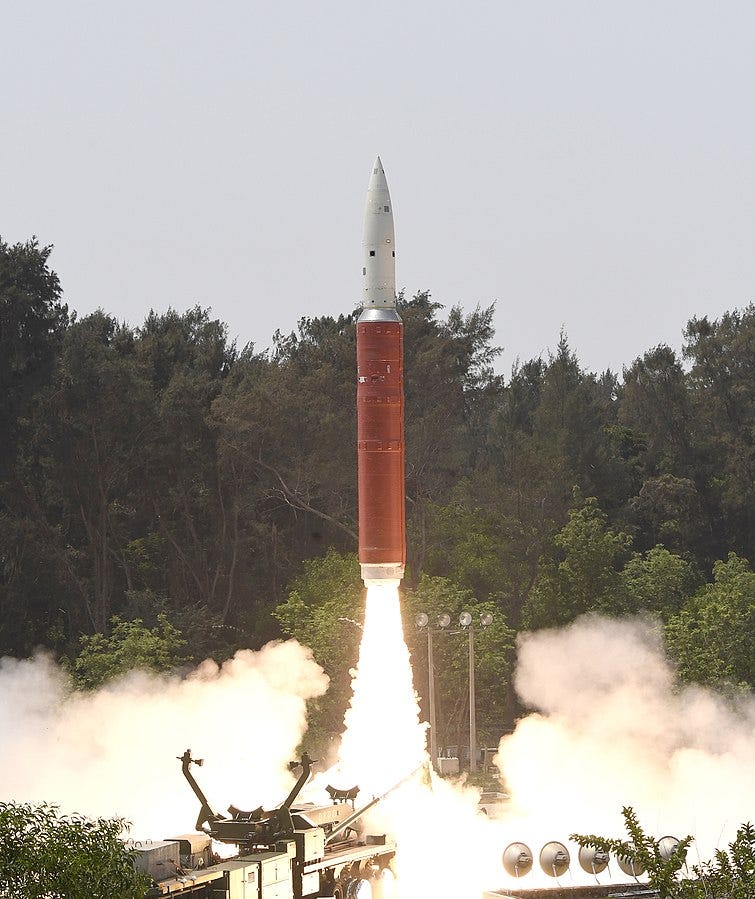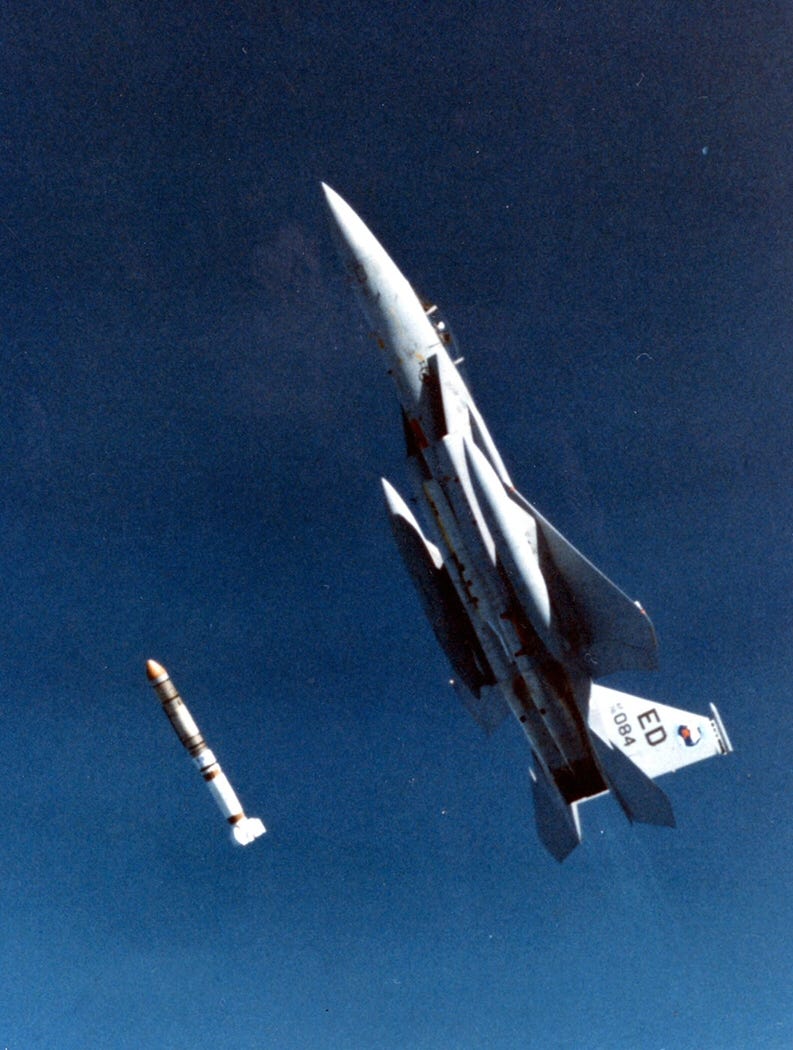The Global Race for Anti-Satellite Supremacy
Deep dive into high-stakes battle for control and defense in Earth's final frontier
Thanks 🙏🏼🙏🏼 to all our readers who supported our Kickstarter campaign regarding The Space Deck. Anyone who have still not placed their orders, can please grab them ASAP!! Only 18 more days to go, thereafter it will be available at a higher cost. Please check the project here.
In the expansive void above us, a silent battle rages—not of starfighters and cruisers, but of technology, policy, and deterrence. Central to this celestial contest are anti-satellite (ASAT) weapons, sophisticated systems designed to neutralize or destroy satellites for strategic military advantages. This article delves into the intricacies of ASAT weapons, exploring their technology, differentiating them from conventional missiles and rockets, and discussing the nations that possess these formidable capabilities.
Recent News Article about Anti-Satellite Weapon stated:
National Security Advisor Jake Sullivan briefed select members of Congress on new U.S. intelligence about the system on Feb. 15, and later that day, White House spokesperson John Kirby confirmed to reporters that the system is “related to an anti-satellite weapon that Russia is developing.”
What is an Anti-Satellite Weapon?

Anti-satellite weapons are a class of space warfare weapons designed to incapacitate or annihilate satellites, thereby hindering an adversary's intelligence gathering, navigation, and military communication capabilities. The concept of ASAT systems isn't new; it has evolved since the Cold War era as part of the space race and strategic defense initiatives. These weapons can be launched from the ground, air, or space platforms, and they target satellites in Earth's orbit to disrupt the enemy's space-based capabilities.
Technology Behind Anti-Satellite Weapons
Launch Mechanisms
ASAT systems utilize a variety of launch platforms. Ground-based ASAT weapons, like missiles, are launched from terrestrial sites, while air-launched ASATs are deployed from aircraft, granting them mobility and a broader range of attack vectors. Space-based platforms, though less common due to international treaties and the complexities of positioning weapons in orbit, represent a direct and potent method of engaging satellite targets.
Finding the Target
The process of identifying and tracking a satellite target involves sophisticated radar and telescopic systems. Ground stations and space surveillance networks continually monitor the positions of satellites, using radar for all-weather, day-and-night tracking, and telescopes for high-precision observations in favorable conditions. Once a target is identified, the ASAT system calculates the interception course, adjusting for the satellite's orbit and speed.
Construction Methodology
Constructing an ASAT weapon involves integrating propulsion, guidance, and destruction mechanisms into a single system. The propulsion unit must be capable of delivering the weapon into the vicinity of the target satellite, often requiring stages to reach different orbits. The guidance system, incorporating advanced algorithms and sensors, ensures the weapon can adjust its trajectory mid-flight to intercept a moving target. Finally, the destruction mechanism, which can be a kinetic impactor (physically colliding with the target), an explosive warhead, or even directed energy (lasers), is chosen based on the desired effect—disabling or completely destroying the satellite.
Difference Between ASAT Weapons and Missiles/Rockets
While ASAT weapons share similarities with missiles and rockets—such as propulsion and guidance systems—their objectives and operational environments distinguish them significantly. Missiles and rockets are primarily designed for atmospheric use or to place payloads into orbit. In contrast, ASAT weapons must operate in the vacuum of space, requiring them to withstand different physical stresses and thermal conditions. Furthermore, while missiles are often aimed at static or predictably moving targets, ASAT weapons must calculate complex intercept trajectories to hit satellites moving at several kilometers per second in orbit.
Countries with Anti-Satellite Capabilities
A few nations have demonstrated ASAT capabilities, reflecting the significant technological, financial, and strategic investments required to develop and deploy these systems:
United States
The United States has been a pioneer in the development of ASAT technology, with programs dating back to the early days of the Cold War.
ASM-135 ASAT: One of the most notable systems is the ASM-135 ASAT, an air-launched missile system developed in the 1980s. Launched from an F-15 Eagle, the ASM-135 was designed to intercept and destroy satellites in low Earth orbit through direct impact. It successfully demonstrated this capability in 1985 by destroying the Solwind P78-1 satellite.
Ground-Based Interceptor (GBI): Though primarily designed for missile defense, the Ground-Based Interceptor has capabilities that could potentially be adapted for ASAT missions. The system uses a hit-to-kill approach, similar to that required for intercepting satellites.
Russia
Russia, inheriting the Soviet Union’s legacy, has been actively developing and testing its ASAT capabilities over the years.
Nudol ASAT System: The Nudol system is a ground-launched ASAT missile believed to be capable of intercepting satellites in low Earth orbit. While specific details of the system remain classified, it has reportedly been tested multiple times, indicating Russia's continued interest and advancement in ASAT technology.
Soviet-era Co-Orbital Systems: During the Cold War, the Soviet Union developed co-orbital ASAT systems, which involved launching a "killer satellite" that maneuvers close to the target satellite before detonating an explosive charge or using kinetic impact for destruction.
China
China’s ASAT test in 2007 marked its public entry into the realm of space warfare capabilities, drawing international attention and concern.
SC-19 ASAT System: The 2007 test involved a direct-ascent, ground-launched missile that successfully intercepted and destroyed a defunct weather satellite. The test demonstrated China's ability to target satellites in low Earth orbit and significantly contributed to the global conversation on space debris and militarization.
India
India demonstrated its ASAT capabilities more recently, highlighting its emerging role in space and defense technologies.

Mission Shakti: In March 2019, India conducted an ASAT test named Mission Shakti, using a ground-launched missile to successfully intercept and destroy a satellite in low Earth orbit. The test vehicle, a derivative of the ballistic missile defense interceptor, showcased India's indigenous capabilities in missile technology and space warfare.
Anti-satellite weapons represent a critical aspect of modern warfare, offering the capability to undermine adversaries' space-based advantages. The technology behind these systems is complex, integrating advanced propulsion, targeting, and destruction mechanisms to neutralize satellites effectively. While only a handful of nations currently possess operational ASAT systems, their existence and the potential for their use play a significant role in international security and space policy discussions.
Use of ASATs generates space debris, which can collide with other satellites and generate more space debris. A cascading multiplication of space debris could cause Earth to suffer from Kessler syndrome (collisional cascading). As space becomes increasingly congested and contested, understanding and regulating the use of anti-satellite weapons will be paramount to ensuring space remains a domain for peaceful exploration and use.





